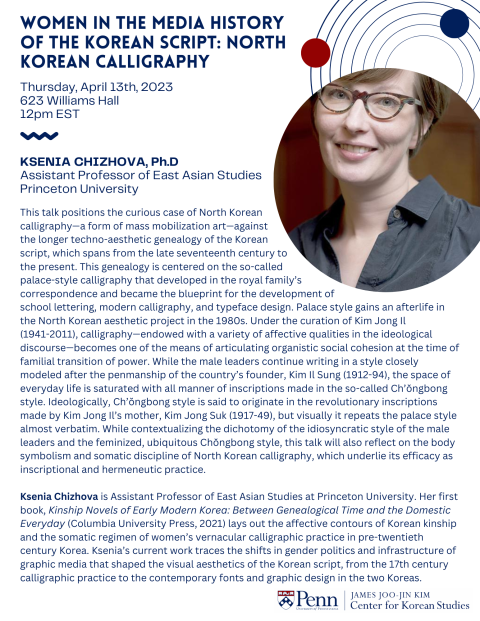
Korean Studies Colloquium
623 Williams Hall
This talk positions the curious case of North Korean calligraphy—a form of mass mobilization art—against the longer techno-aesthetic genealogy of the Korean script, which spans from the late seventeenth century to the present. This genealogy is centered on the so-called palace-style calligraphy that developed in the royal family’s correspondence and became the blueprint for the development of school lettering, modern calligraphy, and typeface design. Palace style gains an afterlife in the North Korean aesthetic project in the 1980s. Under the curation of Kim Jong Il (1941-2011), calligraphy—endowed with a variety of affective qualities in the ideological discourse—becomes one of the means of articulating organistic social cohesion at the time of familial transition of power. While the male leaders continue writing in a style closely modeled after the penmanship of the country’s founder, Kim Il Sung (1912-94), the space of everyday life is saturated with all manner of inscriptions made in the so-called Ch’ŏngbong style. Ideologically, Ch’ŏngbong style is said to originate in the revolutionary inscriptions made by Kim Jong Il’s mother, Kim Jong Suk (1917-49), but visually it repeats the palace style almost verbatim. While contextualizing the dichotomy of the idiosyncratic style of the male leaders and the feminized, ubiquitous Chŏngbong style, this talk will also reflect on the body symbolism and somatic discipline of North Korean calligraphy, which underlie its efficacy as inscriptional and hermeneutic practice.
Ksenia Chizhova is Assistant Professor of East Asian Studies at Princeton University. Her first book, Kinship Novels of Early Modern Korea: Between Genealogical Time and the Domestic Everyday (Columbia University Press, 2021) lays out the affective contours of Korean kinship and the somatic regimen of women’s vernacular calligraphic practice in pre-twentieth century Korea. Ksenia’s current work traces the shifts in gender politics and infrastructure of graphic media that shaped the visual aesthetics of the Korean script, from the 17th century calligraphic practice to the contemporary fonts and graphic design in the two Koreas.
 James Joo-Jin Kim Center for Korean Studies
James Joo-Jin Kim Center for Korean Studies